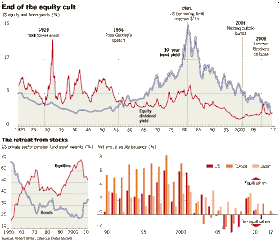A recent
FT op-ed raises the question whether decades of equity cult is about to end,
Allianz,
with a total of about €1.7tn under management, has only 6 per cent of
its insurance portfolio in equities, while 90 per cent is in bonds. A
decade ago, 20 per cent was in equities. It is far from alone:
institutional investors, from pension funds to mutual funds sold
directly to the public, have slashed holdings in the past decade. Stocks
have not been so far out of favour for half a century. Many declare the
“cult of the equity” dead.
With
equity financing expensive, many companies are opting to raise debt
instead, or to retire equity. As equity markets shrink, so does the sway
of the owners of that equity, reducing shareholder control over
companies – and challenging accepted concepts of corporate ownership. Further, with equity returns virtually flat for more than a decade,
the incentive for investors to take risks by funding smaller, more
entrepreneurial companies has declined – eroding a process that has
traditionally given managers the flexibility they need to grow.
Capitalism with less equity finance would follow a much more
conservative model.
As an indicator of the changing trends, the article points to the recent shifts in dividend yields (the amount paid out in dividends per
share divided by the share price). For more than half a century, investors have preferred the lower dividend yields, compared to bond yields, in the hope that the longer term returns from equity valuations (capital gains) will more than compensate the lower interest rate returns. And they have not been disappointed. But now that is changing as the graphic below shows.
According to
Robert Shiller of Yale University, the dividend yield on US stocks is
today 1.97% – above the 1.72% yield on 10-year US
Treasury bonds. The article provides more proof of the transformation,
From
1900 to 2010, they beat inflation by 6.3 per cent a year in the US,
according to a widely used benchmark maintained by London Business
School, compared with only 1.8 per cent for bonds. In the US and the UK,
public pension funds had allocations to equities as high as 70 per cent
only 10 years ago. They are now down to 40 per cent in the UK, and 52
per cent in the US.
However, this pessimism about equities is questioned by those who point to the apparently cyclical nature of the gap between dividend and bond yields. A recent
report by Goldman Sachs claimed that equities are now heavily undervalued and said that given the
current valuations,
it’s time to say a 'long good bye’ to
bonds, and embrace the ‘long good buy’ for equities as they are expected to
embark on an upward trend over the next few years.
In fact, seen from its historical perspective, the ex-post equity risk premium of the S&P 500 over the US Treasury has been dismal.
However, critics point out that the long period of Great Moderation since the early eighties, when inflationary pressures were quelled, have contributed to a long period of stable and low bond yields. They also point to the regulatory reforms, especially sovereign bond holdings, and changes in tax and accounting principles that have all favored bonds. The graphic below shows that government bonds are now more expensive than anytime in history and yields at their lowest.
Therefore, as the FT writes, "The trend cannot continue much longer without yields on bonds turning
negative – meaning investors would pay for the privilege of lending to
the government." Therefore, it is argued, it may not be far when bond yields start to revert
to historically normal levels, which will in turn trigger off bond sell-offs. This money would then start flowing back into the other big investment opportunity, equities. Does this mean that the apparent lull in equities is merely the beginning of a resurgence of equities?




No comments:
Post a Comment